| Leonese | |
|---|---|
| Llionés | |
| Native to | Spain, Portugal |
| Region | Provinces of León (north and west), Zamora (north-west) in Castilla y León, in Spain,[1][2][3] and the towns of Rionor and Guadramil in northeastern Portugal;[4][5] Mirandese dialect in Portugal. |
Native speakers | 20,000–50,000 (2008)[6][7] |
| Official status | |
Official language in | As of 2010, has special status in the Spanish autonomous community of Castile and León |
| Language codes | |
| ISO 639-2 | ast |
| ISO 639-3 | ast |
| Glottolog | leon1250 |
| Linguasphere | 51-AAA-cc |
| IETF | ast-u-sd-escl |
 Astur-Leonese is classified as Definitely Endangered by the UNESCO Atlas of the World's Languages in Danger | |
Leonese (Leonese: llionés, Asturian: lleonés) is a set of vernacular Romance language varieties currently spoken in northern and western portions of the historical region of León in Spain (the modern provinces of León, Zamora, and Salamanca) and a few adjoining areas in Portugal. In this narrow sense, Leonese is distinct from the dialects grouped under the Asturian language.[8] There is no real linguistic division, though; it is only a purely political and identitary division, as dialectal areas (western, central, eastern...) are in fact shaped along a north-south axis (thus encompassing lands both north and south of the mountains, both in Asturias and in Castile and León). In the past, it was spoken in a wider area, including most of the historical region. The current number of Leonese speakers is estimated at 20,000 to 50,000.[6][7][9] The westernmost fringes of the provinces of León and Zamora are in the territory of the Galician language, although there is dialectal continuity between the linguistic areas.
The Leonese and Asturian dialects have long been recognized as a single language, currently known as Astur-Leonese or Asturian-Leonese. Sometimes the language as a whole is simply called "Asturian" because of several reasons, such as the Leonese dialects being on the brink of extinction, or the widespread ignorance of its very existence (even in León), as well as their lack of recognition and institutional support (as opposed to their Asturian counterparts). On the other hand, Menéndez Pidal and fellow scholars[10] discussed a "Leonese language" descending from Latin and encompassing two groups: the Asturian dialects on one hand, and dialects spoken in the provinces of León and Zamora in Spain and a related dialect in Trás-os-Montes (Portugal), on the other hand.[8][11][4]
Unlike Asturian, which is regulated by the Academy of the Asturian Language (ALLA) and promoted by the Asturian Government and local legislation, the Leonese dialects are not officially promoted or regulated.
Moreover, the Asturleonese dialect (considered part of the Leonese dialects) of Miranda do Douro (Portugal), Mirandese, is most certainly a dialect on its own, considering the numerous differences it has when compared to dialects in the Spanish side. In fact, it is often considered as a separate language, especially in Portugal, where it has been granted official recognition,[12] and is regulated by the Institute of the Mirandese Language. Thus, Asturleonese is sometimes considered a group of two languages, Asturian or Asturleonese proper, and Mirandese.
Name
Menéndez Pidal used "Leonese" for the entire linguistic area, including Asturias. This designation has been replaced by Ibero-Romance scholars with "Asturian-Leonese", but "Leonese" is still often used to denote Asturian-Leonese by non-speakers of Asturian or Mirandese.[4][13]
Linguistic description
Phonology
In Leonese, any of five vowel phonemes, /a, e, i, o, u/, may occur in stressed position. In the unstressed positions, the distinction between close and mid vowels is neutralized in favor of the archiphonemes /ɪ/ and /ʊ/.[14]
Grammar
Leonese has two genders (masculine and feminine) and two numbers (singular and plural). The main masculine noun and adjective endings are -u for singular and -os for plural. Typical feminine endings are -a for singular and -as for plural. Masculine and feminine nouns ending in -e in the singular take -es for the plural.
Adjectives
Adjectives agree with nouns in number and gender.
Comparative table
| Gloss | Latin | Galician | Portuguese | Astur-Leonese | Spanish |
|---|---|---|---|---|---|
| Diphthongization of ŏ and ĕ | |||||
| door | pŏrta(m) | porta | porta | puerta | puerta |
| eye | ŏc(u)lu(m) | ollo | olho | güeyu güechu |
ojo |
| time | tĕmpu(m) | tempo | tempo | tiempu | tiempo |
| land | tĕrra(m) | terra | terra | tierra | tierra |
| Initial f- | |||||
| make | facere | facer | fazer | facer | hacer |
| iron | ferru(m) | ferro | ferro | fierru | hierro |
| Initial l- | |||||
| fireplace | lare(m) | lar | lar | llar ḷḷar |
lar |
| wolf | lupu(m) | lobo | lobo | llobu ḷḷobu |
lobo |
| Initial n- | |||||
| Christmas | natal(is) nativitate(m) |
nadal | natal | ñavidá | navidad |
| Initial pl-, cl-, fl- | |||||
| flat | planu(m) | chan chao |
plano | chanu llanu |
llano |
| key | clave(m) | chave | chave | chave llave |
llave |
| flame | flamma(m) | chama | chama | chama llama |
llama |
| Falling diphthongs | |||||
| thing | causa(m) | cousa | cousa coisa |
co(u)sa | cosa |
| blacksmith | ferrariu(m) | ferreiro | ferreiro | ferre(i)ru | herrero |
| -ct- and -lt- | |||||
| made | factu(m) | feito | feito | feitu fechu |
hecho |
| night | nocte(m) | noite | noite | nueite nueche |
noche |
| much | multu(m) | moito muito |
muito | muitu mueitu muchu |
mucho |
| listen | auscultare | escoitar escuitar |
escuitar (archaic)
escutar |
escuitare escueitare escuchar |
escuchar |
| mn | |||||
| man | hom(i)ne(m) | home | homem | home | hombre |
| hunger, famine | fam(i)ne(m) | fame | fome | fame | hambre |
| fire | lum(i)ne(m) | lume | lume | llume ḷḷume |
lumbre |
| Intervocalic -l- | |||||
| ice / frost | gelu(m) gelare |
xeo | gelo | xelu | hielo |
| fern | filictu(m) | fieito, fento | feto | feleitu feichu |
helecho |
| -ll- | |||||
| castle | castellu(m) | castelo | castelo | castiellu castieḷḷu |
castillo |
| Intervocalic -n- | |||||
| frog | rana(m) | ra(n) | rã | rana | rana |
| -lj- | |||||
| woman | muliere(m) | muller | mulher | muyer mucher |
mujer |
| c’l, t’l, g’l | |||||
| razor | novac(u)la(m) | navalla | navalha | ñavaya | navaja |
| old | vet(u)lu(m) | vello | velho | vieyu viechu |
viejo |
| tile | teg(u)la(m) | tella | telha | teya | teja |
Historical, social and cultural aspects
History
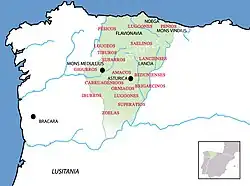
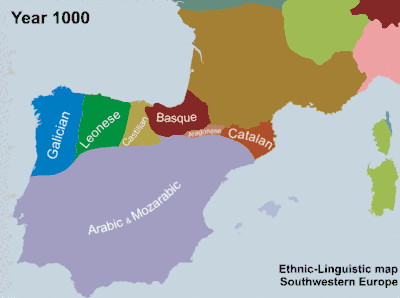
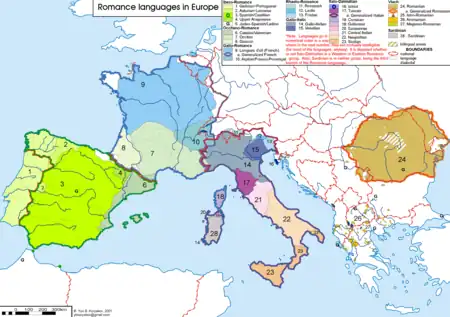
The native languages of Leon, Zamora, Asturias, and the Terra de Miranda in Portugal are the result of the evolution of Latin introduced by Roman conquerors in the region. Their colonization and organization led to the Conventus Asturum, with its capital at Asturica Augusta (present-day Astorga, Spain, the centre of Romanization for the indigenous tribes).[15]
The city of Astorga was sacked by the Visigoths in the 5th century, and never regained its former prominence. The region remained unified until the eighth-century Islamic invasion. Around the 11th century, it began to be defined as Leonese territory roughly corresponding to the southern conventus. In medieval León, the Romance Galician, Asturian-Leonese, and Castilian languages evolved and spread south.
The first known text in Asturian-Leonese is the Nodicia de kesos, written between 974 and 980 AD, an inventory of cheeses owned by a monastery written in the margin of the reverse of a document written in Latin.[16] During the 12th and 13th centuries, Leonese reached its territorial zenith as the administrative language of the Kingdom of León, a literary language (Poema de Elena y María[17] and the Libro de Alexandre),[18] in the Leonese court, judiciary (with the translation of the Visigothic Liber Iudicum or Liber Iudiciorum into Leonese), administration, and organization.[19]
After the 1230 union of Leon and Castile, Leonese had greater written and institutional use, although at the end of the 13th century Castilian began to replace it as a written language.[20] Leonese became an oral, rural language with little literary development.
At the beginning of the 20th century, it survived in oral form only in mid-western León and western Zamora provinces. Its scientific study and a nascent cultural movement began in the province of Leon in 1906. During the 1950s and 60s, the number of Leonese speakers and the area in which it was spoken decreased.
Use and distribution
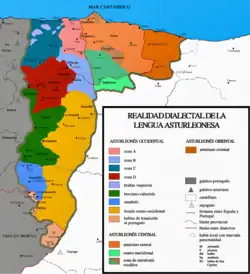
Although the Astur-Leonese linguistic domain covers most of the principality of Asturias, the north and west of the province of Leon, the northeast of Zamora, both provinces in Castile and León, and the region of Miranda do Douro in the east of the Portuguese district of Bragança, this article focuses on the autonomous community of Castile and León. Borrego Nieto wrote that the area in where Leonese is best preserved, defined as "area 1", consists of the regions of Babia and Laciana, part of Los Argüellos, eastern Bierzo and La Cabrera; in Zamora, non-Galician Sanabria.[3]
Borrego Nieto describes another geographical circle, which he calls "area 2", where Leonese is fading: " ... It is extended to the regions between the interior area and the Ribera del Órbigo (Maragatería, Cepeda, Omaña ... ). In Zamora, the region of La Carballeda – with the subregion La Requejada – and Aliste, with at least a part of its adjacent lands (Alba and Tábara). This area is characterized by a blur and progressive disappearance, greater as we move to the East, of the features still clearly seen in the previous area. The gradual and negative character of this characteristic explains how vague the limits are".
Number of speakers

A "speaker of Leonese" is defined here as a person who knows (and can speak) a variety of Leonese. There is no linguistic census of the number of Leonese speakers in the provinces of León and Zamora, and estimates vary from 5,000 to 50,000.
| Sociolinguistic study | Number of speakers |
|---|---|
| II Estudiu sociollingüísticu de Lleón: Identidá, conciencia d'usu y actitúes llingüístiques de la población lleonesa[6] | 50,000 |
| Facendera pola Llengua newsletter[21] | 25,000 |
| El asturiano-leonés: aspectos lingüísticos, sociolingüísticos y legislación[22] | 20,000 to 25,000 |
| Linguas en contacto na bisbarra do Bierzo: castelán, astur-leonés e galego.[23] | 2,500 to 4,000 (El Bierzo, Ribas de Sil, Fornela, and La Cabrera) |
Studies

Two sociolinguistic studies, in northern Leon and the entire province[24][6] analysed the prevalence of Leonese and the linguistic attitudes of its speakers. According to the latter, maintenance of the language is the primary wish but opinions differ about how to do so. Almost 37 per cent think that the language should be kept for nonofficial uses, and about 30 per cent believe it should be on a par with Spanish. Twenty-two per cent favour its disappearance. Nearly the population supports granting official status to Leonese by amending the Statute of Autonomy. About 70 per cent favour linguistic coordination between León and Asturias, with 20 per cent opposing. Leonese in education is favoured by more than 63 per cent of the population, and opposed by about 34 per cent. Institutional promotion of the dialect, especially by town councils, was favoured by more than 83 per cent of respondents.
Recognition
The Statute of Autonomy of Castile and León, amended 30 November 2007, addresses the status of Spanish, Leonese, and Galician. According to Section 5.2, "Leonese will be specifically protected by the institutions for its particular value within the linguistic patrimony of the Community. Its protection, usage and promotion will be regulated".
On 24 February 2010, a parliamentary group from the Spanish Socialist Workers' Party presented a proposition to the Cortes of Castile and León to recognize the value of Leonese and implement a plan to protect and promote it. Although the proposition was approved unanimously by the plenary session of the parliament of Castile and León on 26 May, the government's position has not changed.
Vitality
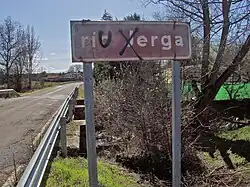
UNESCO, in its Atlas of the World's Languages in Danger, listed Leonese in the most at-risk category. The category's criteria are:
- unofficial
- without legitimized significant use in the news media
- low levels of proficiency and use
- poor social prestige
- not used as a medium of primary education
- not used in official toponyms
Standardization
The Autonomous Community of Castile and León lacks a government agency to promote minority languages and a nongovernmental agency in an advisory capacity in matters pertaining to minority languages. The Academy of the Asturian Language has sponsored linguistic and sociolinguistic research, which encompasses the non-Asturian dialects of Asturian-Leonese. Two congresses about Leonese have been held, at which the following measures were proposed to move towards language standardization:
- Based on articles 5.2 and 5.3 of the Statute of Autonomy,[25] raise the legal status of Leonese to equal that of Galician.
- Create an autonomous administrative organ under the Department of Culture and Tourism responsible for protecting and promoting Leonese and Galician.
- Introduce Leonese into adult and childhood education.
- Recover native toponymy with bilingual signage.
- Support cultural and literary Leonese and its publications and collaborate with associations which base their work on the recovery of Leonese, encourage Leonese in social media, and promote literary contests in the dialect.
- Promote study of Leonese through the universities and centres of study and investigation such as the Institute of Studies in Zamora, the Cultural Institute in Leon, the Institute of Studies of El Bierzo and the Marcelo Macías Institute of Studies in Astorga.
- Coordinate and cooperate with linguistic institutions, study centres, and administrations in the rest of the Asturialeonese linguistic area.
- Require local governments to assume responsibility for the recovery of Leonese.
Promotion
For about 15 years cultural associations have offered Leonese-language courses, sometimes with the support of local administrations in the provinces of Leon and Zamora. In 2001, the Universidad de León (University of León) created a course for teachers of Leonese. The dialect can be studied in the larger villages of León, Zamora and Salamanca provinces as El Fueyu courses, following an agreement between the Leonese provincial government and the organization. The Leonese Language Teachers and Monitors Association (Asociación de Profesores y Monitores de Llingua Llïonesa) was created in 2008 to promote Leonese-language activities.
Literature
Leonese literature includes:
- Benigno Suárez Ramos, El tío perruca, 1976. ISBN 978-84-400-1451-1.
- Cayetano Álvarez Bardón, Cuentos en dialecto leonés, 1981. ISBN 978-84-391-4102-0.
- Xuan Bello, Nel cuartu mariellu, 1982. ISBN 978-84-300-6521-9.
- Miguel Rojo, Telva ya los osos, 1994. ISBN 978-84-8053-040-8.
- Manuel García Menéndez, Corcuspin el Rozcayeiru, 1984. ISBN 978-84-600-3676-0.
- Manuel García Menéndez, Delina nel valle'l Faloupu, 1985. ISBN 978-84-600-4133-7.
- Eva González Fernández, Poesía completa : 1980–1991, 1991. ISBN 978-84-86936-58-7.
- Cuentos de Lleón: Antoloxía d'escritores lleoneses de güei, 1996. ISBN 84-87562-12-4.
- Roberto González-Quevedo, L.lume de l.luz, 2002. ISBN 978-84-8168-323-3.
- Roberto González-Quevedo, Pol sendeiru la nueite, 2002. ISBN 978-84-95640-37-6.
- Roberto González-Quevedo, Pan d'amore : antoloxía poética 1980–2003, 2004. ISBN 978-84-95640-95-6.
- Roberto González-Quevedo, El Sil que baxaba de la nieve, 2007. ISBN 978-84-96413-31-3.
- Emilce Núñez Álvarez, Atsegrías ya tristuras, 2005. ISBN 978-84-8177-093-3.
- Luis Cortés Vázquez, Leyendas, cuentos y romances de Sanabria, 2003. ISBN 978-84-95195-55-5.
- Ramón Menéndez Pidal, El dialecto leonés (Commemorative edition with stories and poems in Leonese), 2006. ISBN 978-84-933781-6-5.
- Cuentos populares leoneses (escritos por niños), 2006. ISBN 978-84-611-0795-7.
- Nicolás Bartolomé Pérez, Filandón: lliteratura popular llionesa, 2007. ISBN 978-84-933380-7-7.
- José Aragón y Escacena, Entre brumas, 1921. ISBN 978-84-8012-569-7.
- Francisco Javier Pozuelo Alegre, Poemas pa nun ser lleídos, 2008. ISBN 978-84-612-4484-3.
- Xosepe Vega Rodríguez, Epífora y outros rellatos, 2008. ISBN 978-84-612-5315-9.
- Xosepe Vega Rodríguez, Breve hestoria d'un gamusinu, 2008. ISBN 978-84-612-5316-6.
- Antoine De Saint-Exupéry, El Prencipicu (Translation of The Little Prince), 2009. ISBN 978-84-96872-03-5.
- Ramón Rei Rodríguez, El ñegru amor, 2009. ISBN 978-84-613-1824-7.
- Juan Andrés Oria de Rueda Salguero, Llogas carbayesas, 2009. ISBN 978-84-613-1822-3.
See also
References
- ↑ Herrero Ingelmo, José Luis (March 2006). "El leonés en Salamanca cien años después" [Ramón Menéndez Pidal and The Leonese dialect] (PDF). In Morala Rodríguez, José Ramón (ed.). Ramón Menéndez Pidal y El dialecto leonés (1906–2006). Ramón Menéndez Pidal y El dialecto leonés. Beltenebros (in Spanish). León, Spain: Instituto Castellano y Leonés de la Lengua. pp. 207–235. ISBN 978-84-935774-5-2.
- ↑ Llorente Maldonado de Guevara, Antonio (1986). "Las hablas vivas de Zamora y Salamanca en la actualidad". In Alvar López, Manuel (ed.). Lenguas peninsulares y proyección hispánica (in Spanish). Madrid: Fundación Friedrich Ebert; Instituto de Cooperación Iberoamericana. pp. 107–131. ISBN 9788439872092.
- 1 2 Borrego Nieto, Julio (1996). "Leonés". In Alvar López, Manuel (ed.). Manual de dialectología hispánica: el español de España. Barcelona, Spain: Editorial Ariel. pp. 139–158. ISBN 978-84-344-8217-3.
- 1 2 3 Menéndez Pidal 1906.
- ↑ Segura da Cruz, Luísa; Saramago, João; Vitorino, Gabriela (September 1993). "Os dialectos leoneses em território português: coesão e diversidade". Variação Linguística no Espaço, no Tempo e na Sociedade. Encontro Regional da Associação Portuguesa de Linguística. Miranda do Douro: Associação Portuguesa de Linguística. pp. 281–293.
- 1 2 3 4 González Riaño & García Arias 2008.
- 1 2 Sánchez Prieto, Raúl (2008). "La elaboración y aceptación de una norma lingüística en comunidades dialectalmente divididas: el caso del leonés y del frisio del norte" (PDF). In Sánchez Prieto, Raúl; Veith, Daniel; Martínez Areta, Mikel (eds.). Mikroglottika Yearbook 2008 (in Spanish). Vol. 1. Peter Lang. pp. 145–153. hdl:10366/19373. ISBN 978-3-631-58027-1.
- 1 2 Krüger, Fritz (2006) [1914]. González Ferrero, Juan Carlos (ed.). Estudio fonético-histórico de los dialectos españoles occidentales (in Spanish). Translated by Sánchez Nieto, M.ª Teresa; González Martínez, María. Zamora, Spain: Instituto de Estudios Zamoranos "Florián de Ocampo". p. 13. ISBN 84-96100-13-8.
- ↑ García Gil 2008, p. 12.
- ↑ García Gil 2008, p. 10.
- ↑ Marcos de Dios, Ángel; Serra, Pedro (1999). Historia de la literatura portuguesa (in Spanish). Salamanca, Spain: Luso-Española de Ediciones. p. 9. ISBN 84-930359-4-7.
- ↑ Lei n.º 7/99, de 29 de Janeiro (in Portuguese) – via diariodarepublica.pt
- ↑ Morala Rodríguez 2009.
- ↑ Pardo Fernández 2008.
- ↑ Santos Yanguas, Juan (1985). Comunidades indígenas y administración romana en el Noroeste hispánico. Leioa, Spain: Universidad del País Vasco. ISBN 978-84-7585-019-1.
- ↑ Fernández Catón, José M.ª (2004). "La "Nodicia de Kesos" y los problemas de la documentación del siglo X sobre el origen de los monasterios independientes de Rozuela y Cillanueva". Orígenes de las lenguas romances en el Reino de León: siglos IX-XII (in Spanish). Vol. 1. León, Spain: Centro de Estudios e Investigación "San Isidoro". pp. 35–86. ISBN 84-87667-65-1.
- ↑ Menéndez Pidal, Ramón (1914). "Elena y María (Disputa del clérigo y el caballero): Poesía leonesa inédita del siglo XIII". Revista de Filología Española (in Spanish). ISSN 0210-9174.
- ↑ Bishop, Sarah G. (1977). The Leonese features in the Madrid manuscript of the Libro de Alexandre (PDF) (PhD). Ohio State University.
- ↑ Carrasco Cantos, Pilar; Carrasco Cantos, Inés (1998). Estudio léxico-semántico de los fueros leoneses de Zamora, Salamanca, Ledesma y Alba de Tormes: Concordancias lematizadas. Publicaciones de la Cátedra de Historia de la Lengua Española. Universidad de Granada. ISBN 978-84-338-2315-1.
- ↑ Lomax, Derek W. (April 1968). "La lengua oficial de Castilla". In Rosetti, Alexandru; Reinheimer-Rîpeanu, Sanda (eds.). Actele celui de-al XII-lea congres internaţional de lingvistică şi filologie romanică. International Congress of Romance Linguistics and Philology (in Spanish). Vol. 2. Academiei Republicii Socialiste România (published 1971). pp. 411–417.
- ↑ "La "llingua" de los leoneses" (PDF). Furmientu (in Spanish).
- ↑ García Gil 2008.
- ↑ Gómez Bautista, Alberto (2006). "Linguas en contacto na bisbarra do Bierzo: castelán, astur-leonés e galego" (PDF). Ianua: Revista Philologica Romanica (in Galician). Romania Minor. 6: 15–22. ISSN 1616-413X. Retrieved 25 August 2022.
- ↑ González Riaño, Xosé Antón; García Arias, Xosé Lluis (2006). Estudiu sociollingüísticu de Lleón: Identidá, conciencia d'usu y actitúes llingüístiques nes fasteres que llenden con Asturies. Estaya Sociollingüística (in Asturian). Vol. 3. Oviedo, Spain: Academia de la Llingua Asturiana.
- ↑ "Reforma del Estatuto de Autonomía de Castilla y León" [Amendment to the Statute of Autonomy of the Castille and Leon]. Article 5, Ley Orgánica No. 14/2007 of 1 December 2007 (in Spanish). Vol. 288. pp. 49486–49505 – via BOE.
Sources
- García Gil, Héctor (2008). Asturian-leonese: Linguistic, Sociolinguistic and Legal Aspects (PDF). Working Papers. Vol. 25. Translated by Jenkins, Peter David. Barcelona, Spain: Mercator Legislation; CIEMEN. ISSN 2013-102X. Archived from the original (PDF) on 27 March 2014.
- González Riaño, Xosé Antón; García Arias, Xosé Lluis (2008). II Estudiu Sociollingüísticu De Lleón: Identidá, conciencia d'usu y actitúes llingüístiques de la población lleonesa. Estaya Sociollingüística (in Asturian). Vol. 4. Oviedo, Spain: Academia de la Llingua Asturiana. ISBN 978-84-8168-448-3.
- López Morales, Humberto (August 1965). "Elementos leoneses en la lengua del teatro pastoril de los siglos XV y XVI" (PDF). In Sánchez Romeralo, Jaime; Poulussen, Norbert (eds.). Actas del Segundo Congreso Internacional de Hispanistas. Congress of the International Association of Hispanists. Nijmegen, The Netherlands: Asociación Internacional de Hispanistas (published 1967). pp. 411–419.
- Morala Rodríguez, José Ramón (2009). El leonés en el siglo XXI: Un romance milenario ante el reto de su normalización. Beltenebros. Vol. 23. Burgos, Spain: Instituto Castellano y Leonés de la Lengua. ISBN 978-84-936383-8-2.
- Menéndez Pidal, Ramón (1906). "El dialecto leonés" (PDF). Revista de Archivos, Bibliotecas y Museos (in Spanish). No. 2–3. Cuerpo de Archiveros, Bibliotecarios y Arqueólogos. pp. 128–172, 294–311. ISSN 0034-771X.
- Pardo Fernández, Abel (2008). "El Llïonés y las TICs" (PDF). In Sánchez Prieto, Raúl; Veith, Daniel; Martínez Areta, Mikel (eds.). Mikroglottika Yearbook 2008 (in Spanish). Vol. 1. Peter Lang. pp. 55–65. ISBN 978-3-631-58027-1. Archived from the original on 20 September 2009.
{{cite book}}: CS1 maint: unfit URL (link) - Staaff, Erik (1907). Étude sur l'ancien dialecte léonais d'après les chartes du XIIIe siècle. Uppsala, Sweden.
{{cite book}}: CS1 maint: location missing publisher (link)
Further reading
- Galmés de Fuentes, Álvaro; Catalán Menéndez-Pidal, Diego (1960). Trabajos sobre el dominio románico leonés. Gredos. ISBN 978-84-249-3436-1..
- Gessner, Emil (1900). Das Altleonesische: Ein Beitrag zur Kenntnis des Altspanischen (in German).
- Hanssen, Friedrich (1896). "Estudios sobre la conjugación leonesa" (PDF). Anales de la Universidad de Chile. 94: 753–808. ISSN 0717-8883.
- Hanssen, Friedrich (1910). "Los infinitivos leoneses del poema de Alejandro" (PDF). Bulletin Hispanique. Presses Universitaires de Bordeaux. 12 (2): 135–139. doi:10.3406/hispa.1910.1644.
- Krüger, Fritz (1923). "El dialecto de San Ciprián de Sanabria". Revista de Filología Española: Anejos (in Spanish). 4. ISSN 0210-9174.
Reprinted in: Krüger, Fritz (2001). El dialecto de San Ciprián de Sanabria: monografía leonesa (3rd ed.). Madrid: Fundación Menéndez Pidal. ISBN 978-84-89934-04-7.